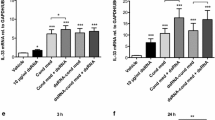Abstract
Background
Chlamydophila pneumoniae may contribute to the pathogenesis of asthmatic airway inflammation through chemical mediators secreted by C. pneumoniae-infected bronchial epithelial cells (BECs). Recently, CCL20 and vascular endothelial growth factor (VEGF) were reported to be released from BECs and to play a role in the pathogenesis of asthma.
Objective and Methods
To determine if C. pneumoniae infection of BECs induces the secretion of CCL20 and VEGF, we measured that by ELISA in human BECs infected with C. pneumoniae. Transcripts of CCL20 and VEGF were assayed by semi-quantitative RT-PCR. To investigate the underlying mechanism, the activation of MAPK and intracellular reactive oxygen species (ROS) in these C. pneumoniae-infected BECs was measured, as well as the effects of inhibitors of MAPK and ROS on CCL20 and VEGF expression.
Results
Compared with non-infected BECs, C. pneumoniae-infected BECs showed enhanced secretion of CCL20 and VEGF. C. pneumoniae-infected BECs also showed enhanced intracellular ROS and an increased ratio of phosphorylated to non-phosphorylated p38. Inhibition of p38 suppressed CCL20 and VEGF secretion, as did a NADPH oxidase blocker and an antioxidant, in C. pneumoniae-infected BECs.
Conclusion
C. pneumoniae infection of BECs may play a role in the pathogenesis of asthma through the enhanced production of CCL20 and VEGF. The association between increased cytokine production and increased intracellular ROS suggests that antioxidants may benefit asthmatics in selected situations.






Similar content being viewed by others
References
Cho YS, Kim TB, Lee TH, Moon KA, Lee J, Kim YK, et al. Chlamydia pneumoniae infection enhances cellular proliferation and reduces steroid responsiveness of human peripheral blood mononuclear cells via a tumor necrosis factor-alpha-dependent pathway. Clin Exp Allergy. 2005;35:1625–31. doi:10.1111/j.1365-2222.2005.02391.x.
Reibman J, Hsu Y, Chen LC, Bleck B, Gordon T. Airway epithelial cells release MIP-3alpha/CCL20 in response to cytokines and ambient particulate matter. Am J Respir Cell Mol Biol. 2003;28:648–54. doi:10.1165/rcmb.2002-0095OC.
Weckmann M, Collison A, Simpson JL, Kopp MV, Wark PA, Smyth MJ, et al. Critical link between TRAIL and CCL20 for the activation of TH2 cells and the expression of allergic airway disease. Nat Med. 2007;13:1308–15. doi:10.1038/nm1660.
Lukacs NW, Prosser DM, Wiekowski M, Lira SA, Cook DN. Requirement for the chemokine receptor CCR6 in allergic pulmonary inflammation. J Exp Med. 2001;194:551–5. doi:10.1084/jem.194.4.551.
de Heer HJ, Hammad H, Soullie T, Hijdra D, Vos N, Willart MA, et al. Essential role of lung plasmacytoid dendritic cells in preventing asthmatic reactions to harmless inhaled antigen. J Exp Med. 2004;200:89–98. doi:10.1084/jem.20040035.
Moser M, Murphy KM. Dendritic cell regulation of T H 1-T H 2 development. Nat Immunol. 2000;1:199–205. doi:10.1038/79734.
Neurath MF, Finotto S, Glimcher LH. The role of Th1/Th2 polarization in mucosal immunity. Nat Med. 2002;8:567–73. doi:10.1038/nm0602-567.
Lee CG, Link H, Baluk P, Homer RJ, Chapoval S, Bhandari V, et al. Vascular endothelial growth factor (VEGF) induces remodeling and enhances TH2-mediated sensitization and inflammation in the lung. Nat Med. 2004;10:1095–103. doi:10.1038/nm1105.
Lee YC, Kwak YG, Song CH. Contribution of vascular endothelial growth factor to airway hyperresponsiveness and inflammation in a murine model of toluene diisocyanate-induced asthma 1. J Immunol. 2002;168:3595–600.
Asai K, Kanazawa H, Kamoi H, Shiraishi S, Hirata K, Yoshikawa J. Increased levels of vascular endothelial growth factor in induced sputum in asthmatic patients. Clin Exp Allergy. 2003;33:595–9. doi:10.1046/j.1365-2222.2003.01576.x.
Chetta A, Zanini A, Foresi A, D’Ippolito R, Tipa A, Castagnaro A, et al. Vascular endothelial growth factor up-regulation and bronchial wall remodelling in asthma. Clin Exp Allergy. 2005;35:1437–42. doi:10.1111/j.1365-2222.2005.02360.x.
Lambrecht BN, Hammad H. The other cells in asthma: dendritic cell and epithelial cell crosstalk. Curr Opin Pulm Med. 2003;9:34. doi:10.1097/00063198-200301000-00006.
Pichavant M, Charbonnier AS, Taront S, Brichet A, Wallaert B, Pestel J, et al. Asthmatic bronchial epithelium activated by the proteolytic allergen Der p 1 increases selective dendritic cell recruitment. J Allergy Clin Immunol. 2005;115:771–8. doi:10.1016/j.jaci.2004.11.043.
Von Hertzen L, Toyryla M, Gimishanov A, Bloigu A, Leinonen M, Saikku P, et al. Asthma, atopy and Chlamydia pneumoniae antibodies in adults. Clin Exp Allergy. 1999;29:522–8. doi:10.1046/j.1365-2222.1999.00504.x.
von HL. Role of persistent infection in the control and severity of asthma: focus on Chlamydia pneumoniae. Eur Respir J. 2002;19:546–56. doi:10.1183/09031936.02.00254402.
Johnston SL, Martin RJ. Chlamydophila pneumoniae and Mycoplasma pneumoniae: a role in asthma pathogenesis? Am J Respir Crit Care Med. 2005;172:1078–89. doi:10.1164/rccm.200412-1743PP.
Francis JN, Sabroe I, Lloyd CM, Durham SR, Till SJ. Elevated CCR6+ CD4+ T lymphocytes in tissue compared with blood and induction of CCL20 during the asthmatic late response. Clin Exp Immunol. 2008;152:440–7.
Chang L, Karin M. Mammalian MAP kinase signalling cascades. Nature. 2001;410:37–40. doi:10.1038/35065000.
Demedts IK, Bracke KR, Van Pottelberge GR, Testelmans D, Verleden GM, Vermassen FE, et al. Accumulation of dendritic cells and increased CCL20 levels in the airways of COPD patients. Am J Respir Crit Care Med. 2007;175:998–1005. doi:10.1164/rccm.200608-1113OC.
Tao F, Gonzalez-Flecha B, Kobzik L. Reactive oxygen species in pulmonary inflammation by ambient particulates. Free Radic Biol Med. 2003;35:327–40. doi:10.1016/S0891-5849(03)00280-6.
Nel AE, Diaz-Sanchez D, Li N. The role of particulate pollutants in pulmonary inflammation and asthma: evidence for the involvement of organic chemicals and oxidative stress. Curr Opin Pulm Med. 2001;7:20. doi:10.1097/00063198-200101000-00004.
Acknowledgment
This work was supported by a grant (no. A080250) from the Korea Health 21 R&D project of the Ministry of Health, Welfare, and Family, Republic of Korea, to Y.S.C.
Author information
Authors and Affiliations
Corresponding author
Additional information
Tae-Bum Kim and Keun-Ae Moon equally contributed to this work.
Rights and permissions
About this article
Cite this article
Kim, TB., Moon, KA., Lee, KY. et al. Chlamydophila pneumoniae Triggers Release of CCL20 and Vascular Endothelial Growth Factor from Human Bronchial Epithelial Cells Through Enhanced Intracellular Oxidative Stress and MAPK Activation. J Clin Immunol 29, 629–636 (2009). https://doi.org/10.1007/s10875-009-9306-8
Received:
Accepted:
Published:
Issue Date:
DOI: https://doi.org/10.1007/s10875-009-9306-8




